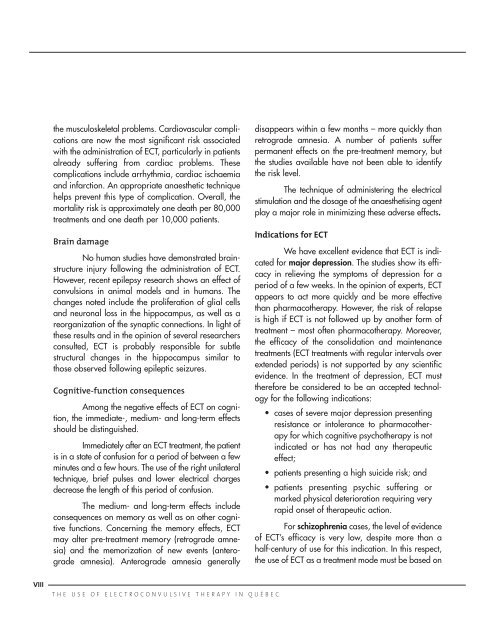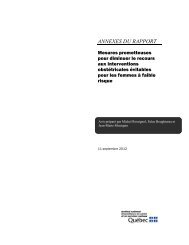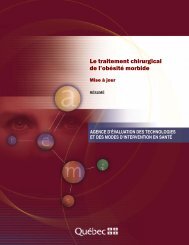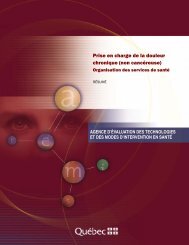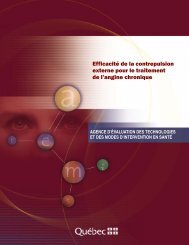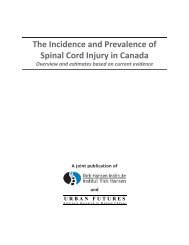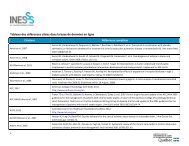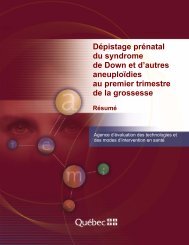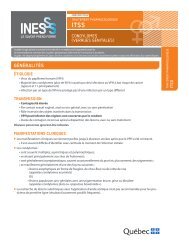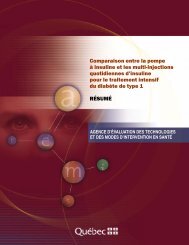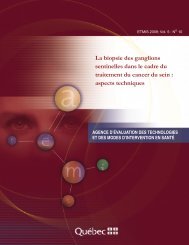The use of electroconvulsive therapy in Quebec - INESSS
The use of electroconvulsive therapy in Quebec - INESSS
The use of electroconvulsive therapy in Quebec - INESSS
You also want an ePaper? Increase the reach of your titles
YUMPU automatically turns print PDFs into web optimized ePapers that Google loves.
VIII<br />
the musculoskeletal problems. Cardiovascular complications<br />
are now the most significant risk associated<br />
with the adm<strong>in</strong>istration <strong>of</strong> ECT, particularly <strong>in</strong> patients<br />
already suffer<strong>in</strong>g from cardiac problems. <strong>The</strong>se<br />
complications <strong>in</strong>clude arrhythmia, cardiac ischaemia<br />
and <strong>in</strong>farction. An appropriate anaesthetic technique<br />
helps prevent this type <strong>of</strong> complication. Overall, the<br />
mortality risk is approximately one death per 80,000<br />
treatments and one death per 10,000 patients.<br />
Bra<strong>in</strong> damage<br />
No human studies have demonstrated bra<strong>in</strong>structure<br />
<strong>in</strong>jury follow<strong>in</strong>g the adm<strong>in</strong>istration <strong>of</strong> ECT.<br />
However, recent epilepsy research shows an effect <strong>of</strong><br />
convulsions <strong>in</strong> animal models and <strong>in</strong> humans. <strong>The</strong><br />
changes noted <strong>in</strong>clude the proliferation <strong>of</strong> glial cells<br />
and neuronal loss <strong>in</strong> the hippocampus, as well as a<br />
reorganization <strong>of</strong> the synaptic connections. In light <strong>of</strong><br />
these results and <strong>in</strong> the op<strong>in</strong>ion <strong>of</strong> several researchers<br />
consulted, ECT is probably responsible for subtle<br />
structural changes <strong>in</strong> the hippocampus similar to<br />
those observed follow<strong>in</strong>g epileptic seizures.<br />
Cognitive-function consequences<br />
Among the negative effects <strong>of</strong> ECT on cognition,<br />
the immediate-, medium- and long-term effects<br />
should be dist<strong>in</strong>guished.<br />
Immediately after an ECT treatment, the patient<br />
is <strong>in</strong> a state <strong>of</strong> confusion for a period <strong>of</strong> between a few<br />
m<strong>in</strong>utes and a few hours. <strong>The</strong> <strong>use</strong> <strong>of</strong> the right unilateral<br />
technique, brief pulses and lower electrical charges<br />
decrease the length <strong>of</strong> this period <strong>of</strong> confusion.<br />
<strong>The</strong> medium- and long-term effects <strong>in</strong>clude<br />
consequences on memory as well as on other cognitive<br />
functions. Concern<strong>in</strong>g the memory effects, ECT<br />
may alter pre-treatment memory (retrograde amnesia)<br />
and the memorization <strong>of</strong> new events (anterograde<br />
amnesia). Anterograde amnesia generally<br />
THE USE OF ELECTROCONVULSIVE THERAPY IN QUÉBEC<br />
disappears with<strong>in</strong> a few months – more quickly than<br />
retrograde amnesia. A number <strong>of</strong> patients suffer<br />
permanent effects on the pre-treatment memory, but<br />
the studies available have not been able to identify<br />
the risk level.<br />
<strong>The</strong> technique <strong>of</strong> adm<strong>in</strong>ister<strong>in</strong>g the electrical<br />
stimulation and the dosage <strong>of</strong> the anaesthetis<strong>in</strong>g agent<br />
play a major role <strong>in</strong> m<strong>in</strong>imiz<strong>in</strong>g these adverse effects.<br />
Indications for ECT<br />
We have excellent evidence that ECT is <strong>in</strong>dicated<br />
for major depression. <strong>The</strong> studies show its efficacy<br />
<strong>in</strong> reliev<strong>in</strong>g the symptoms <strong>of</strong> depression for a<br />
period <strong>of</strong> a few weeks. In the op<strong>in</strong>ion <strong>of</strong> experts, ECT<br />
appears to act more quickly and be more effective<br />
than pharmaco<strong>therapy</strong>. However, the risk <strong>of</strong> relapse<br />
is high if ECT is not followed up by another form <strong>of</strong><br />
treatment – most <strong>of</strong>ten pharmaco<strong>therapy</strong>. Moreover,<br />
the efficacy <strong>of</strong> the consolidation and ma<strong>in</strong>tenance<br />
treatments (ECT treatments with regular <strong>in</strong>tervals over<br />
extended periods) is not supported by any scientific<br />
evidence. In the treatment <strong>of</strong> depression, ECT must<br />
therefore be considered to be an accepted technology<br />
for the follow<strong>in</strong>g <strong>in</strong>dications:<br />
• cases <strong>of</strong> severe major depression present<strong>in</strong>g<br />
resistance or <strong>in</strong>tolerance to pharmaco<strong>therapy</strong><br />
for which cognitive psycho<strong>therapy</strong> is not<br />
<strong>in</strong>dicated or has not had any therapeutic<br />
effect;<br />
• patients present<strong>in</strong>g a high suicide risk; and<br />
• patients present<strong>in</strong>g psychic suffer<strong>in</strong>g or<br />
marked physical deterioration requir<strong>in</strong>g very<br />
rapid onset <strong>of</strong> therapeutic action.<br />
For schizophrenia cases, the level <strong>of</strong> evidence<br />
<strong>of</strong> ECT’s efficacy is very low, despite more than a<br />
half-century <strong>of</strong> <strong>use</strong> for this <strong>in</strong>dication. In this respect,<br />
the <strong>use</strong> <strong>of</strong> ECT as a treatment mode must be based on


